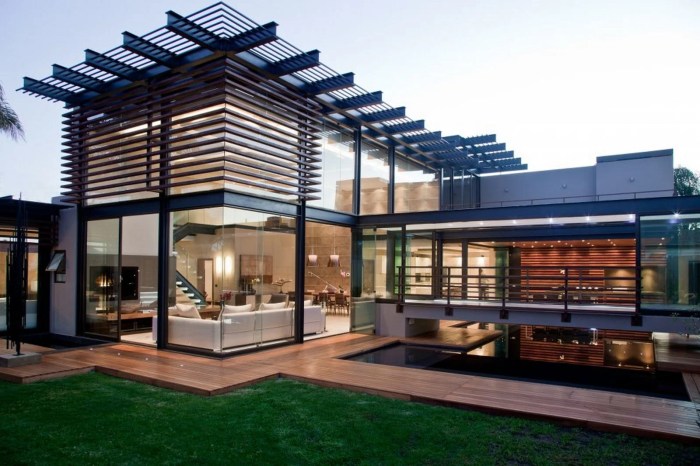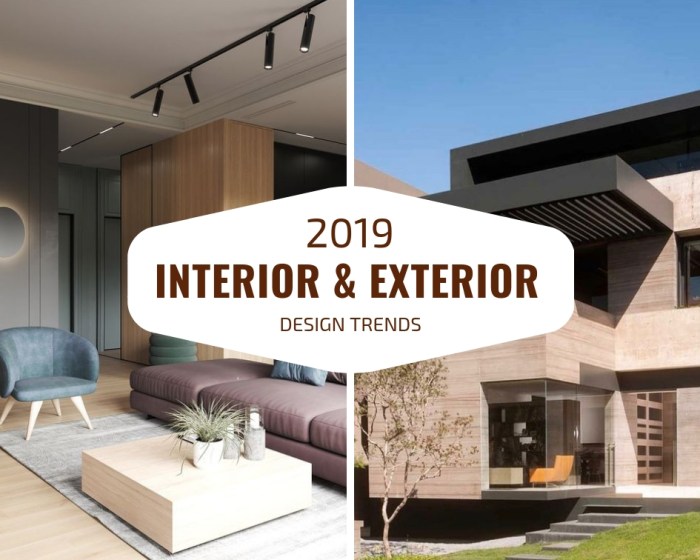Delving into Interior and exterior architecture design tips, this introduction immerses readers in a unique and compelling narrative, with a focus on creating harmonious and functional spaces that reflect individual style and taste.
From balancing elements to choosing the perfect color schemes, this guide explores the key principles and techniques that can transform any interior or exterior into a stunning masterpiece.
Interior Design Principles
When it comes to interior design, there are key principles that help create visually appealing and functional spaces. Let's explore some of these important concepts.
The Importance of Balance in Interior Design
Balance is crucial in interior design as it helps create a sense of equilibrium and harmony in a space. There are two types of balance: symmetrical and asymmetrical. Symmetrical balance involves arranging elements in a space in a mirror-like fashion, while asymmetrical balance involves a more dynamic and spontaneous arrangement.
- Example of Symmetrical Balance:A room with identical furniture pieces on each side of a central axis creates a sense of formality and order.
- Example of Asymmetrical Balance:Mixing different sizes, shapes, and textures on either side of a central point can create a visually interesting and balanced space.
Contrast in Interior Design
Contrast plays a significant role in interior design by adding visual interest and depth to a space. It involves the use of elements that are different from each other to create a dynamic and engaging environment.
- Example of Contrast:Pairing a dark-colored accent wall with light-colored furniture can create a striking visual contrast that draws the eye and adds drama to the room.
- Example of Contrast:Mixing modern furniture with vintage decor pieces can create an eclectic and unique space with a mix of styles.
The Role of Focal Points
Focal points are key elements in a room that draw attention and create a sense of interest. They help guide the eye and establish a visual hierarchy within a space.
- Example of Focal Point:Placing a statement piece of artwork above a fireplace can create a focal point that anchors the room and adds personality to the space.
- Example of Focal Point:Using a bold-colored rug in a neutral room can create a focal point that adds a pop of color and visual interest.
Color Schemes

Choosing the right color scheme for a room can greatly impact the overall look and feel of the space. Whether you want to create a calming atmosphere or make a bold statement, understanding different color schemes is essential in interior design.
Monochromatic vs Complementary Color Schemes
When it comes to color schemes, two popular options are monochromatic and complementary.
- Monochromatic:This color scheme involves using different shades and tints of a single color. It creates a harmonious and soothing look in a room. To create visual interest, vary the intensity of the color or add texture.
- Complementary:Complementary color schemes involve using colors that are opposite each other on the color wheel. This creates a vibrant and dynamic look. To prevent overwhelming the space, use one color as the dominant hue and the other as an accent.
Incorporating Accent Colors
When incorporating accent colors into a room, consider the 60-30-10 rule. This guideline suggests using 60% of a dominant color, 30% of a secondary color, and 10% of an accent color. This helps maintain balance and visual interest in the space.
Accent colors can be introduced through accessories, artwork, or furniture pieces to add pops of color without overpowering the room.
Furniture Arrangement

When it comes to interior design, furniture arrangement plays a crucial role in creating a functional and aesthetically pleasing space. Proper furniture layout can enhance the flow of a room, maximize space, and create a harmonious environment.To create a functional furniture layout, consider the following tips:
Concept of Traffic Flow
- Ensure there is enough space for easy movement around the furniture.
- Avoid blocking pathways or doorways with furniture pieces.
- Create designated areas for specific activities to streamline traffic flow.
- Consider the natural flow of movement within the space when placing furniture.
Maximizing Space in Small Rooms
- Opt for multifunctional furniture pieces, such as a sofa bed or storage ottoman, to maximize space.
- Use vertical storage solutions like shelves or wall-mounted cabinets to free up floor space.
- Choose furniture with exposed legs to create a sense of openness and airiness in small rooms.
- Utilize mirrors to visually expand the space and reflect light throughout the room.
Lighting Design
Effective lighting design is crucial in enhancing the overall look and feel of interior spaces. It not only illuminates the area but also sets the mood and highlights architectural features.
Types of Lighting
- Ambient Lighting: Provides overall illumination to the space, usually through ceiling-mounted fixtures like chandeliers or recessed lights.
- Task Lighting: Focused light for specific activities like reading or cooking, often provided by desk lamps or under-cabinet lights.
- Accent Lighting: Used to highlight architectural features, artwork, or focal points in the room, typically through spotlights or wall-mounted fixtures.
Layering Lighting for Ambiance and Functionality
Layering different types of lighting is key to creating a well-balanced and functional space. By combining ambient, task, and accent lighting, you can achieve both practical illumination and a warm, inviting atmosphere.
Highlighting Architectural Features
Use lighting strategically to draw attention to unique architectural elements like exposed brick walls, vaulted ceilings, or intricate molding. Positioning accent lights or wall washers can create depth and visual interest in the space.
Ultimate Conclusion
As we conclude our exploration of Interior and exterior architecture design tips, remember that the key to successful design lies in the details. By incorporating these tips and tricks, you can elevate your space to new heights of elegance and sophistication.
FAQ Summary
How important is balance in interior design?
Balance is crucial in interior design as it creates a sense of harmony and visual equilibrium in a space. It helps in ensuring that no single element overpowers the others, resulting in a well-designed and visually appealing room.
What are some tips for maximizing space in small rooms?
To maximize space in small rooms, consider using multi-functional furniture, utilizing vertical storage solutions, and incorporating mirrors to create an illusion of space. Additionally, opting for light, neutral colors can make a room feel more spacious.
How can lighting be used to highlight architectural features?
Lighting can be strategically placed to draw attention to architectural features such as archways, columns, or textured walls. By using spotlights or accent lighting, you can create focal points that enhance the overall design of the space.



